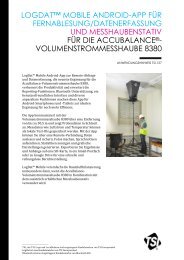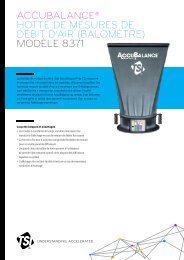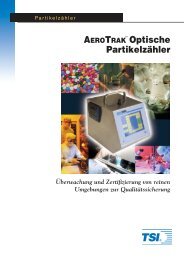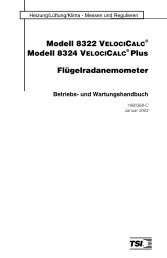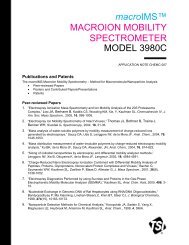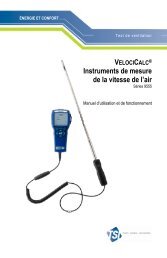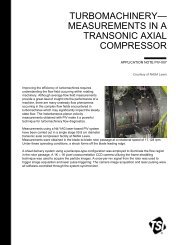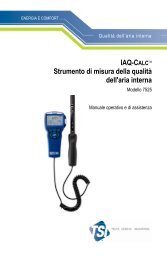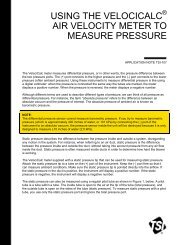DustTrak DRX Aerosol Monitor Theory of Operation ... - TSI
DustTrak DRX Aerosol Monitor Theory of Operation ... - TSI
DustTrak DRX Aerosol Monitor Theory of Operation ... - TSI
You also want an ePaper? Increase the reach of your titles
YUMPU automatically turns print PDFs into web optimized ePapers that Google loves.
mass fractions (PM1, PM2.5, Respirable/PM4, PM10/Thoracic, and TPM). The size segregated mass<br />
concentration is obtained as follows:<br />
PM1 = PM2.5 – PM1-2.5<br />
PM2.5 = Photometric signal × calibration factor<br />
Respirable / PM4 = PM2.5 + PM2.5-4<br />
PM10 / Thoracic = PM4 + PM4-10<br />
TPM = PM10+ PM>10<br />
Laser Diode<br />
Exhaust<br />
Orifice<br />
Laser<br />
Beam<br />
Mirror<br />
Beam Shaping<br />
Optics<br />
<strong>Aerosol</strong> Measurement<br />
Flowmeter<br />
HEPA Filter<br />
Sheath Air<br />
Pump<br />
<strong>Aerosol</strong> Inlet<br />
Light Trap<br />
Viewing<br />
Volume<br />
Photo<br />
Detector<br />
Gravimetric<br />
Filter<br />
Protection<br />
Filter<br />
Dampening<br />
Chamber<br />
Optics<br />
Chamber<br />
-2-<br />
Signal Acquisition and Processing<br />
Single Particle<br />
Pulses<br />
Photometric<br />
Voltage<br />
Size Segregated<br />
Mass Concentration<br />
(eg. PM1, PM2.5, PM4 & PM10)<br />
The algorithms used by the DUSTTRAK <strong>DRX</strong> <strong>Aerosol</strong> <strong>Monitor</strong> yield a mass measurement technique that<br />
is superior to either a basic photometer or Optical Particle Counter (OPC). While photometers can be used<br />
at high mass concentrations, they do not give any size information (unless used with size selective inlet<br />
conditioners) and significantly underestimate particle mass contributed by large particles. On the other<br />
hand, OPCs provide size information, however they cannot be used at high mass concentration. The<br />
DUSTTRAK <strong>DRX</strong> <strong>Aerosol</strong> <strong>Monitor</strong> is able to combine the advantages <strong>of</strong> both the measurement techniques<br />
to improve the overall accuracy <strong>of</strong> the mass measurement.<br />
The DUSTTRAK <strong>DRX</strong> <strong>Aerosol</strong> <strong>Monitor</strong> is able to measure mass concentrations with greater accuracy<br />
because <strong>of</strong> its ability to measure single particles >1 µm, since the photometric signal is less sensitive to<br />
large particles. In addition, the DUSTTRAK <strong>DRX</strong> compensates for coincidence error using a dead-time<br />
correction algorithm. Furthermore, the DUSTTRAK <strong>DRX</strong> <strong>Aerosol</strong> <strong>Monitor</strong> converts the single particle<br />
pulses to aerodynamic size by proprietary factory or custom calibrations, significantly reducing mass<br />
calculation errors due to particle density, refractive index and shape on the calculated mass concentration.<br />
As a result, the DUSTTRAK <strong>DRX</strong> <strong>Aerosol</strong> <strong>Monitor</strong> size segregated mass fraction measurement has the size<br />
resolution <strong>of</strong> an OPC along with a much higher mass concentration range like a typical photometer.



